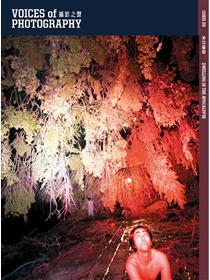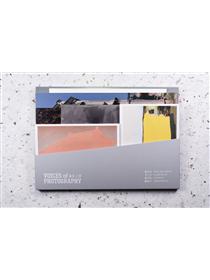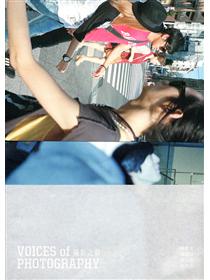


從曲柄、畫盤、窺孔,到鏡片、膠卷、燈泡⋯⋯,繞經各種物質,影像顯現,通 過雙手與身體,穿越視網膜和意識。在攝影與電影盛行之前,十七世紀以 降的視覺裝置已率先創造出新的知覺經驗與樂趣,並與不同技術媒介及視 聽文化相互組構。本期由一系列光學玩具與視覺裝置展開──魔術畫片、 旋轉畫筒、幻透鏡、實用鏡、翻頁式放映機⋯⋯,從動態視覺技術閃現的開端 ,探索影像的操作、生產與感知的關聯。
本期《攝影之聲》也如同一台彼此連動的書寫裝置,投映出影像機具歷程的 不同面向──許鈞宜探討早期光學玩具與哲學概念的構連,揭開由視覺觸 發的思索。林巧芳在動畫影格的空隙間,剖視受連續運動幻覺牽引的感知 樣態。唐宏峰考察晚清時期自西方引進的「全景畫」,揭示此視覺幻景對近 代中國視覺現代性與思想啟蒙的潛在影響。新垣夢乃查訪發源於日本二十 世紀三〇年代說演故事的連環圖像媒介「紙芝居」作為帝國視聽劇場的流 轉;陳涵郁則特寫1941年由皇民奉公會在殖民地台灣發行的國策紙芝居, 顯現感知政治的歷史路徑。此外,本期訪問實驗電影創作者許岑竹,側寫 她以家庭日常用品組裝的視覺裝置所嘗試創造在地影像經驗的可能;另外 也專訪日本京都玩具電影博物館館長太田米男,分享他創設民間博物館的 經歷與特色館藏。
「Artist’s Showcase」單元中,珍妮特.梅伊(Jeanette May)的鏡頭審視漸 遭淘汰的現代工業製品,在如靜物畫般的布局裡折射出人類技術的欲望遺 跡;楊祐丞則運用機械零件與玩具拼裝出各式聲音互動裝置,反思身體與 媒介的運作關係。同時,張世倫以書寫紀念甫逝世的加拿大實驗電影導演 麥可.史諾(Michael Snow),重溫其著名作品《波長》(Wavelength)的詩性
時間流動,以及對電影本質的反身探求。本期也揭載攝影家南.戈丁(Nan Goldin)的系列代表作品,並評介她近期在斯德哥爾摩當代美術館的回顧 展,從她幽微的幻燈展示中,感受滿佈情感記憶的私密凝視。
隨著藝術史學者約翰.泰格(John Tagg)的經典攝影論著《再現之重》中文 譯本的出版,我們收錄了泰格教授與影像文化學者郭力昕的深度訪談,邀 請讀者重新思考「再現之重」的今日意涵,開展建立多樣、複數的攝影史 觀。而伴隨「生活決定意識──高重黎」展覽在台北市立美術館舉行,本期 更特別增附高重黎的創作筆記手稿。作為一位關注影像生產條件與歷史、 並持續帶來啟發的藝術家,在此我們以他對於影像機器不變的詰問──「如 何看見對象、照見自身、發明未來」──向前邁進。
From cranks, picture discs and peepholes, to lenses, film, and light bulbs... Images appear through various materials, the hands and body, the retina and consciousness. Before photography and films became prevalent, visual devices had already taken the lead in creating new perceptual experiences and pleasures that combined different technical media and audio-visual cultures since the 17th century. This issue opens with a variety of optical toys and visual devices – thaumatrope, zoetrope, phenakistiscope, praxinoscope, mutoscope – that will bring you through the operation, production, and perception of image association since the beginning of the sudden emergence of technology of vision in motion.
This issue of Voices of Photography resembles a writing device that connects the dots, projecting different historical aspects of the image machine. Hsu Chun-Yi explores the connection between early optical toys and philosophical concepts and sheds light on the thoughts triggered by visual stimuli. Lin Chiao-Fang dissects the state of perception affected by the illusion of continuous movement in the intervals between animated frames. Tang Hong-Feng uncovers how the “panorama” imported from the West during the late Qing Dynasty had potentially influenced the modernization of Chinese visual culture and the enlightenment of thinking. Arakaki Yumeno looks at how “Kamishibai or paper play, which originated from Japan in the 1930s as a medium for storytelling with a series of pictures, found its way into the imperial audiovisual theater. Chen Han-Yu highlights the historical development of the politics of perception by showcasing the National Policy Kamishibai, published in colonial Taiwan by the Kominhokokai (Public Service Association of Imperial Subjects) in 1941. In addition, this issue also features an interview with Hsu Tsen-Chu, an experimental filmmaker, whose visual devices try to create a local imagery experience through assembling a variety of daily household items. We also interviewed Yoneo Ota, director of the Omochaeiga Museum (Toy Film Museum) in Kyoto, who
1
shared with us his experience establishing a museum and his prized collection.
In “Artist’s Showcase”, Jeanette May examines obsolete modern industrial products in a still life layout through her lens, as they reflect the last vestiges of technology shaped by human desire. Randy Yang puts together various interactive audio installations using mechanical parts and toys, and reflects on the relationship between the body and media. At the same time, Chang Shih-Lun commemorates the late Canadian experimental filmmaker Michael Snow by revisiting the latter’s famous work Wavelength and reflecting on the poetic flow of time and the essence of the cinema. This issue also features works by photographer Nan Goldin and reviews her recent retrospective at the Moderna Museet in Stockholm, Sweden. The faint light from her slideshows resembles an intimate gaze into emotional memories of the past.
Following the publication of the translation of art historian John Tagg’s famous essay collection, The Burden of Representation, we include an interview between Professor Tagg and image culture scholar Kuo Li-Hsin. We invite readers to have a rethink about the meaning of “the burden of representation” in today’s context and form a diverse and plural view of photography histories. Also, we present Kao Chung-Li’s working drafts for the on-going exhibition Re-Present: Kao Chung-Li at the Taipei Fine Arts Museum. As a thought-provoking artist who pays attention to the condition and history of image production, here we move forward with his constant questioning of the image machinery—how to see objects, reflect oneself, and invent the future.
作者簡介:
《Voices of Photography 攝影之聲》是一份影像文化獨立刊物。自2011年創刊,致力探索攝影的文化、歷史與思潮,並持續推動影像閱讀、書寫和研究。
《攝影之聲》長期關注亞洲的攝影發展歷程,重視亞際連結,集結國內外眾多學者、藝術家與文化工作者共同參與撰述,透過每期不同的主題視野,製作出豐富的專題與單元,收錄重要的創作文獻,同時亦以「影言社」為名出版相關叢書,是台灣少數專注於攝影與視覺文化論述領域的獨立出版單位,曾多次獲頒台灣出版界最高榮譽「金鼎獎」各類獎項。
Voices of Photography is an independent publication dedicated to image culture. Since its inception in 2011, VOP has been exploring the culture, history and philosophy of photography, and continually promoting imagery reading, critique, and research.
VOP has always focused on the development of photography in Asia and places special importance on inter-Asian connections. Through collaborative effort with scholars, artists and cultural workers locally and from all over the world, VOP has been gathering important literature and research materials, presenting rich and varied features with a different theme every issue. Now engaging in the publication of written work and criticism through VOP BOOKS, VOP is one of the few independent publishers in Taiwan that focuses on photography and visual culture, earning many accolades at the Golden Tripod Awards, the highest honor in Taiwan’s publishing industry.
 2收藏
2收藏
優惠價: 9 折, NT$ 414 NT$ 460
運送方式:超商取貨、宅配取貨
銷售地區:全球
絕版商品,即時庫存>5
從曲柄、畫盤、窺孔,到鏡片、膠卷、燈泡⋯⋯,繞經各種物質,影像顯現,通 過雙手與身體,穿越視網膜和意識。在攝影與電影盛行之前,十七世紀以 降的視覺裝置已率先創造出新的知覺經驗與樂趣,並與不同技術媒介及視 聽文化相互組構。本期由一系列光學玩具與視覺裝置展開──魔術畫片、 旋轉畫筒、幻透鏡、實用鏡、翻頁式放映機⋯⋯,從動態視覺技術閃現的開端 ,探索影像的操作、生產與感知的關聯。
本期《攝影之聲》也如同一台彼此連動的書寫裝置,投映出影像機具歷程的 不同面向──許鈞宜探討早期光學玩具與哲學概念的構連,揭開由視覺觸 發的思索。林巧芳在動畫影格的空隙間,剖視受連續運動幻覺牽引的感知 樣態。唐宏峰考察晚清時期自西方引進的「全景畫」,揭示此視覺幻景對近 代中國視覺現代性與思想啟蒙的潛在影響。新垣夢乃查訪發源於日本二十 世紀三〇年代說演故事的連環圖像媒介「紙芝居」作為帝國視聽劇場的流 轉;陳涵郁則特寫1941年由皇民奉公會在殖民地台灣發行的國策紙芝居, 顯現感知政治的歷史路徑。此外,本期訪問實驗電影創作者許岑竹,側寫 她以家庭日常用品組裝的視覺裝置所嘗試創造在地影像經驗的可能;另外 也專訪日本京都玩具電影博物館館長太田米男,分享他創設民間博物館的 經歷與特色館藏。
「Artist’s Showcase」單元中,珍妮特.梅伊(Jeanette May)的鏡頭審視漸 遭淘汰的現代工業製品,在如靜物畫般的布局裡折射出人類技術的欲望遺 跡;楊祐丞則運用機械零件與玩具拼裝出各式聲音互動裝置,反思身體與 媒介的運作關係。同時,張世倫以書寫紀念甫逝世的加拿大實驗電影導演 麥可.史諾(Michael Snow),重溫其著名作品《波長》(Wavelength)的詩性
時間流動,以及對電影本質的反身探求。本期也揭載攝影家南.戈丁(Nan Goldin)的系列代表作品,並評介她近期在斯德哥爾摩當代美術館的回顧 展,從她幽微的幻燈展示中,感受滿佈情感記憶的私密凝視。
隨著藝術史學者約翰.泰格(John Tagg)的經典攝影論著《再現之重》中文 譯本的出版,我們收錄了泰格教授與影像文化學者郭力昕的深度訪談,邀 請讀者重新思考「再現之重」的今日意涵,開展建立多樣、複數的攝影史 觀。而伴隨「生活決定意識──高重黎」展覽在台北市立美術館舉行,本期 更特別增附高重黎的創作筆記手稿。作為一位關注影像生產條件與歷史、 並持續帶來啟發的藝術家,在此我們以他對於影像機器不變的詰問──「如 何看見對象、照見自身、發明未來」──向前邁進。
From cranks, picture discs and peepholes, to lenses, film, and light bulbs... Images appear through various materials, the hands and body, the retina and consciousness. Before photography and films became prevalent, visual devices had already taken the lead in creating new perceptual experiences and pleasures that combined different technical media and audio-visual cultures since the 17th century. This issue opens with a variety of optical toys and visual devices – thaumatrope, zoetrope, phenakistiscope, praxinoscope, mutoscope – that will bring you through the operation, production, and perception of image association since the beginning of the sudden emergence of technology of vision in motion.
This issue of Voices of Photography resembles a writing device that connects the dots, projecting different historical aspects of the image machine. Hsu Chun-Yi explores the connection between early optical toys and philosophical concepts and sheds light on the thoughts triggered by visual stimuli. Lin Chiao-Fang dissects the state of perception affected by the illusion of continuous movement in the intervals between animated frames. Tang Hong-Feng uncovers how the “panorama” imported from the West during the late Qing Dynasty had potentially influenced the modernization of Chinese visual culture and the enlightenment of thinking. Arakaki Yumeno looks at how “Kamishibai or paper play, which originated from Japan in the 1930s as a medium for storytelling with a series of pictures, found its way into the imperial audiovisual theater. Chen Han-Yu highlights the historical development of the politics of perception by showcasing the National Policy Kamishibai, published in colonial Taiwan by the Kominhokokai (Public Service Association of Imperial Subjects) in 1941. In addition, this issue also features an interview with Hsu Tsen-Chu, an experimental filmmaker, whose visual devices try to create a local imagery experience through assembling a variety of daily household items. We also interviewed Yoneo Ota, director of the Omochaeiga Museum (Toy Film Museum) in Kyoto, who
1
shared with us his experience establishing a museum and his prized collection.
In “Artist’s Showcase”, Jeanette May examines obsolete modern industrial products in a still life layout through her lens, as they reflect the last vestiges of technology shaped by human desire. Randy Yang puts together various interactive audio installations using mechanical parts and toys, and reflects on the relationship between the body and media. At the same time, Chang Shih-Lun commemorates the late Canadian experimental filmmaker Michael Snow by revisiting the latter’s famous work Wavelength and reflecting on the poetic flow of time and the essence of the cinema. This issue also features works by photographer Nan Goldin and reviews her recent retrospective at the Moderna Museet in Stockholm, Sweden. The faint light from her slideshows resembles an intimate gaze into emotional memories of the past.
Following the publication of the translation of art historian John Tagg’s famous essay collection, The Burden of Representation, we include an interview between Professor Tagg and image culture scholar Kuo Li-Hsin. We invite readers to have a rethink about the meaning of “the burden of representation” in today’s context and form a diverse and plural view of photography histories. Also, we present Kao Chung-Li’s working drafts for the on-going exhibition Re-Present: Kao Chung-Li at the Taipei Fine Arts Museum. As a thought-provoking artist who pays attention to the condition and history of image production, here we move forward with his constant questioning of the image machinery—how to see objects, reflect oneself, and invent the future.
作者簡介:
《Voices of Photography 攝影之聲》是一份影像文化獨立刊物。自2011年創刊,致力探索攝影的文化、歷史與思潮,並持續推動影像閱讀、書寫和研究。
《攝影之聲》長期關注亞洲的攝影發展歷程,重視亞際連結,集結國內外眾多學者、藝術家與文化工作者共同參與撰述,透過每期不同的主題視野,製作出豐富的專題與單元,收錄重要的創作文獻,同時亦以「影言社」為名出版相關叢書,是台灣少數專注於攝影與視覺文化論述領域的獨立出版單位,曾多次獲頒台灣出版界最高榮譽「金鼎獎」各類獎項。
Voices of Photography is an independent publication dedicated to image culture. Since its inception in 2011, VOP has been exploring the culture, history and philosophy of photography, and continually promoting imagery reading, critique, and research.
VOP has always focused on the development of photography in Asia and places special importance on inter-Asian connections. Through collaborative effort with scholars, artists and cultural workers locally and from all over the world, VOP has been gathering important literature and research materials, presenting rich and varied features with a different theme every issue. Now engaging in the publication of written work and criticism through VOP BOOKS, VOP is one of the few independent publishers in Taiwan that focuses on photography and visual culture, earning many accolades at the Golden Tripod Awards, the highest honor in Taiwan’s publishing industry.

※ 二手徵求後,有綁定line通知的讀者,
該二手書結帳減2元。(減2元可累加)
請在手機上開啟Line應用程式,點選搜尋欄位旁的掃描圖示
即可掃描此ORcode
|
||||||||||||||||||
|
||||||||||||||||||
|
||||||||||||||||||












